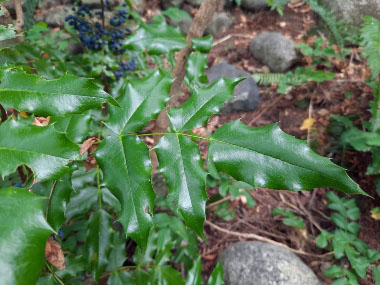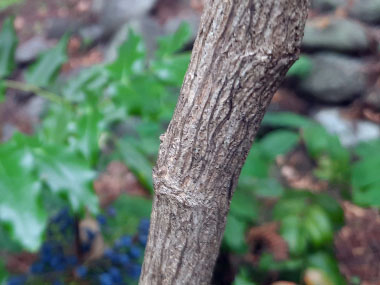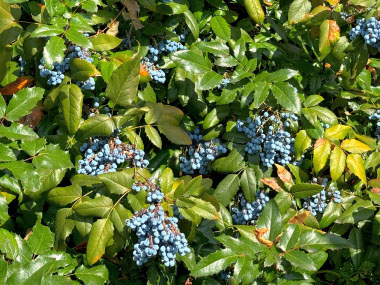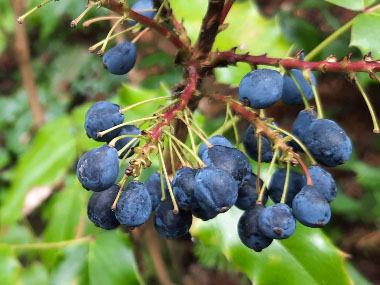







To support our efforts please browse our store (books with medicinal info, etc.).
Oregon grape is a broadleaf evergreen shrub that grows upright, but it tends to spread as far as it grows in height forming thickets. It is typically found at elevations from sea level to 1,220 m (4,000'). Oregon grape was introduced to European gardens in the early 1800s. This shrub has been known botanically by two names: Mahonia and Berberis. Mahonia, honors American horticulturalist Bernard M’Mahon (1775-1816). The name Berberis originates in a similar Arabic name for barberry fruit. Native to the Pacific northwest, the Oregon Horticultural Society nominated the Oregon grape as the state flower in 1892. The state legislature officially adopted the Oregon grape in 1899. The inner bark of Oregon grape was once commonly used as a dye for basket materials. Often it is called Tall Oregon grape because there is a smaller variety. The Dwarf Oregon grape (Mahonia nervosa) can be found in Douglas‐fir and Western red cedar forests in partly‐shaded to shaded locations.
Trunk/Bark
The bark has a somewhat smooth texture with vertical ridges. The outer bark is brownish to gray. Inner bark is bright yellow-to-orange.
Branches/Twigs
The stems and twigs have a thickened, corky appearance.
Height
This shrub typically grows between 1 to 3 metres (3 to 9') but may reach to 5m (15).
Leaves/Needles
This shrub has pinnately compound, glossy, leathery leaves that are very similar to holly leaves. The 5 to 9 dark-green leaflets turns purple and scarlet in colder weather. Spiny teeth line leaf edges giving rise to the species name aquifolium which is a classical name for holly. Aquifolium literally means leaves that have curved hooks like an eagle’s beak.
Flowers
Terminal clusters of bright yellow, bell-shaped flowers appear in early spring. Depending on geographical location, flowers can appear as early as late February. The six yellow petals are enclosed by six yellow sepals. At the base of the flower are three greenish-yellow bracts, less than half as long as the sepals. Each of the six stamens terminates in two spreading branches.
Fruit
Oregon grape produces spherical berries that mature mid-summer, staying on the shrub through the autumn. Ripe berries are dark blue to almost navy. Fruit at maturity measures about 1cm across.
Habitat
This shrub is widespread on the Pacific northwest coast but also can be found across the continent due to wildlife and humans spreading/planting seeds. It prefers shady to partialy shady locations that have moist, rich soils. It can tolerate slightly dry soil.
Edible Parts
Oregon grape berries are safe to eat although they have a very tart taste. Historically, many indigenous peoples ate the tart berries and made a jelly for meats. The juice has a lot of natural pectin and is great made into jelly or wine, by itself or in combination with other berries.
Other Name
Holly-Leaved Barberry.
Recipes
Winter Survival Food Handbook

PDF Plant Magazines
Types of Wild Food
Geographic Zones Seasons
Disclaimer
EdibleWildFood.com is informational in nature. While we strive to be 100% accurate, it is solely up to the reader to ensure proper plant identification. Some wild plants are poisonous or can have serious adverse health effects.
We are not health professionals, medical doctors, nor are we nutritionists. It is up to the reader to verify nutritional information and health benefits with qualified professionals for all edible plants listed in this web site. Please click here for more information.
Why Edible Wild Food?
- Food costs are rising
- Free, wild food is readily abundant
- Wild food adds nutrition to your diet
- Wild food can help treat various medical conditions





